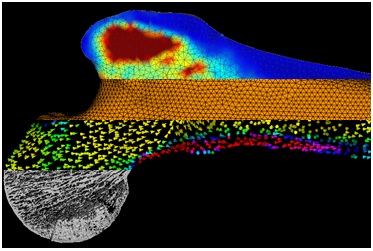From tissue to organ scale
From a biomechanical standpoint, one of the key missing factors in contemporary FE femur models is an accurate quantification of energy absorption under impact loading, such as a sideways fall. With the availability of new impact experimental data, an opportunity exists to develop new FE modeling techniques to simulate this more biofidelic loading configuration.

The primary knowledge gap addressed by this research is the effect of high strain rate on bone tissue mechanics. The first goal of this project is to characterize the mechanical response of impact at the tissue scale using drop tower experiments. Then similarly at the organ scale, the next goal is to construct models of the proximal femur under impact loading and validate the models with experimental data. The final goal is to develop an energy based failure criteria using these models and evaluate its ability to predict femoral fracture in a clinical retrospective study.
Contact
No database information available
